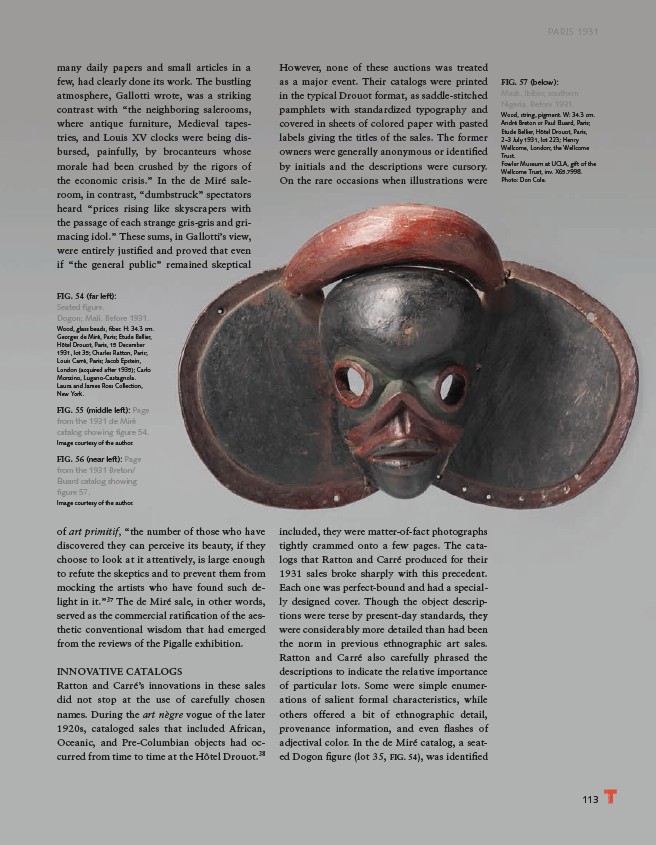
PARIS 1931
113
many daily papers and small articles in a
few, had clearly done its work. The bustling
atmosphere, Gallotti wrote, was a striking
contrast with “the neighboring salerooms,
where antique furniture, Medieval tapestries,
and Louis XV clocks were being disbursed,
painfully, by brocanteurs whose
morale had been crushed by the rigors of
the economic crisis.” In the de Miré saleroom,
in contrast, “dumbstruck” spectators
heard “prices rising like skyscrapers with
the passage of each strange gris-gris and grimacing
idol.” These sums, in Gallotti’s view,
were entirely justified and proved that even
if “the general public” remained skeptical
of art primitif, “the number of those who have
discovered they can perceive its beauty, if they
choose to look at it attentively, is large enough
to refute the skeptics and to prevent them from
mocking the artists who have found such delight
in it.”37 The de Miré sale, in other words,
served as the commercial ratification of the aesthetic
conventional wisdom that had emerged
from the reviews of the Pigalle exhibition.
INNOVATIVE CATALOGS
Ratton and Carré’s innovations in these sales
did not stop at the use of carefully chosen
names. During the art nègre vogue of the later
1920s, cataloged sales that included African,
Oceanic, and Pre-Columbian objects had occurred
from time to time at the Hôtel Drouot.38
However, none of these auctions was treated
as a major event. Their catalogs were printed
in the typical Drouot format, as saddle-stitched
pamphlets with standardized typography and
covered in sheets of colored paper with pasted
labels giving the titles of the sales. The former
owners were generally anonymous or identified
by initials and the descriptions were cursory.
On the rare occasions when illustrations were
included, they were matter-of-fact photographs
tightly crammed onto a few pages. The catalogs
that Ratton and Carré produced for their
1931 sales broke sharply with this precedent.
Each one was perfect-bound and had a specially
designed cover. Though the object descriptions
were terse by present-day standards, they
were considerably more detailed than had been
the norm in previous ethnographic art sales.
Ratton and Carré also carefully phrased the
descriptions to indicate the relative importance
of particular lots. Some were simple enumerations
of salient formal characteristics, while
others offered a bit of ethnographic detail,
provenance information, and even flashes of
adjectival color. In the de Miré catalog, a seated
Dogon figure (lot 35, FIG. 54), was identified
FIG. 54 (far left):
Seated figure.
Dogon; Mali. Before 1931.
Wood, glass beads, fiber. H: 34.3 cm.
Georges de Miré, Paris; Etude Bellier,
Hôtel Drouot, Paris, 15 December
1931, lot 35; Charles Ratton, Paris;
Louis Carré, Paris; Jacob Epstein,
London (acquired after 1935); Carlo
Monzino, Lugano-Castagnola.
Laura and James Ross Collection,
New York.
FIG. 55 (middle left): Page
from the 1931 de Miré
catalog showing figure 54.
Image courtesy of the author.
FIG. 56 (near left): Page
from the 1931 Breton/
Éluard catalog showing
figure 57.
Image courtesy of the author.
FIG. 57 (below):
Mask. Ibibio; southern
Nigeria. Before 1931.
Wood, string, pigment. W: 34.3 cm.
André Breton or Paul Éluard, Paris;
Étude Bellier, Hôtel Drouot, Paris,
2–3 July 1931, lot 223; Henry
Wellcome, London; the Wellcome
Trust.
Fowler Museum at UCLA, gift of the
Wellcome Trust, inv. X65.7998.
Photo: Don Cole.